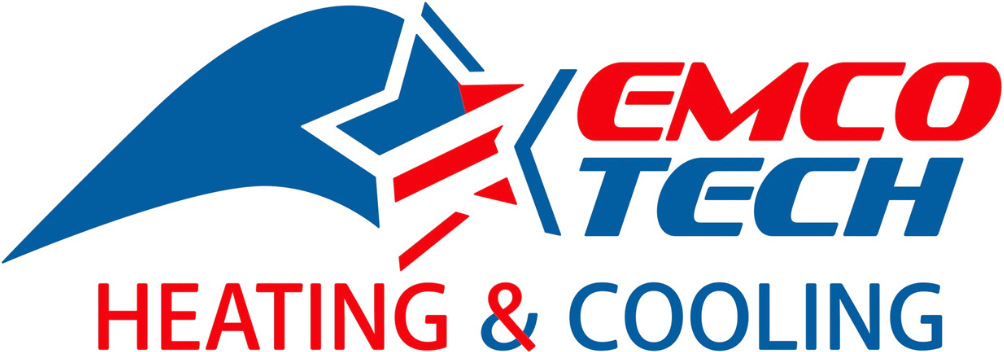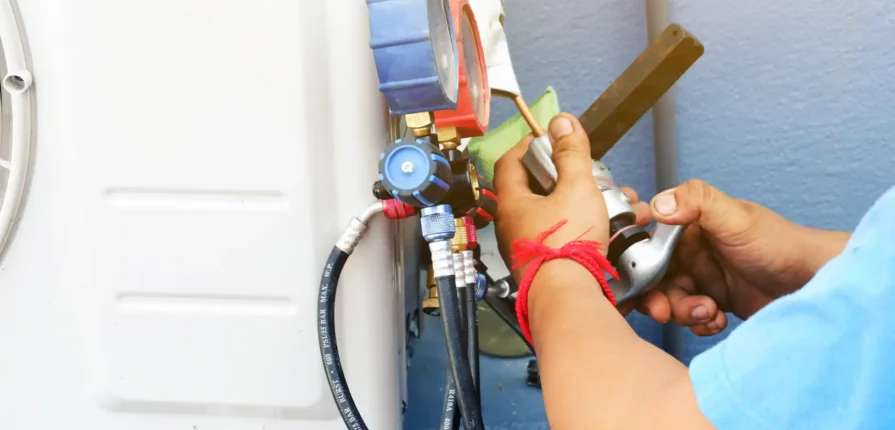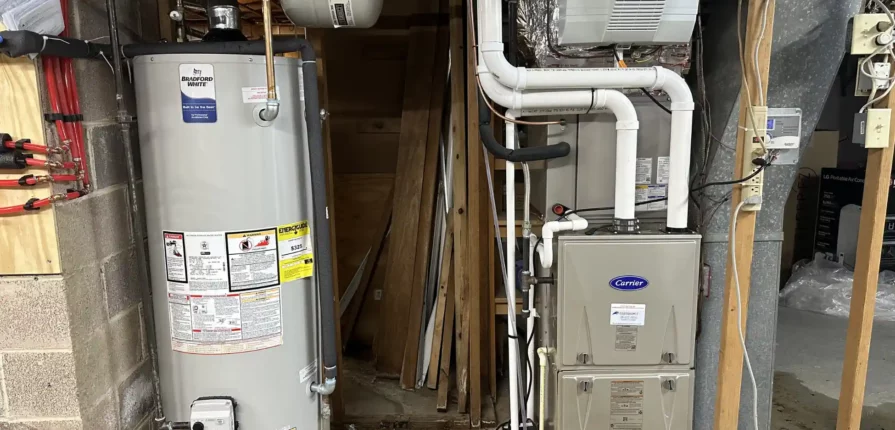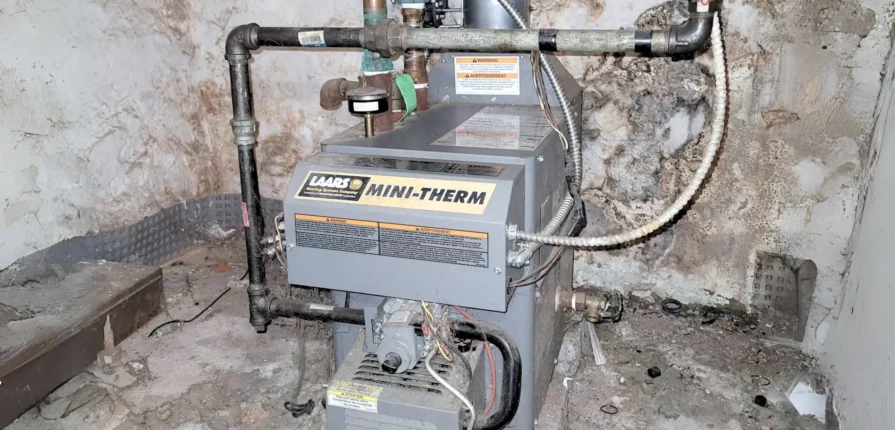Heating & Cooling Glossary from EMCO Tech
AHRI certificate – a document prepared by Air Conditioning, Heating and Refrigeration Institute that specifies SEER rating of the new HVAC equipment that will comply with current standards.
Air Handler – an indoor part of straight cool or heat pump split systems. The main purpose of the air handler is to distribute cold or warm air to the duct work by circulating it through the blower motor.
Annualized Fuel Utilization Efficiency (AFUE) – a measurement of furnace heating efficiency. The higher AFUE rating the more furnace efficiency is.
Aquastat – a device designed to operate on hydronic heating systems and regulate water temperature. Our Boiler & Radiant Heating Services
Barometric Damper – a devise installed on the exhaust line of an oil-fired system (water heater, furnace, boiler) responsible for regulating draft of the flue pipe. Barometric damper looks like a round T-connection with regulator control inside which allows to adjust the draft of the flue pipe.
Blower motor – a major component inside HVAC ducted system (usually furnace or air handler) which is responsible for blowing heated/cooled air through the vent. Blower motor can be: single-speed or variable speed. Single-speed motors operate at one single speed, variable-speed motors adapt their operating speed in accordance with manufacturer energy saving guidelines.
Boiler – a type equipment that is used for producing heat or hot water (or both simultaneously) and deliver the heat though radiators or baseboards. Boilers can be classified based on foul source: gas, oil; or based on application: steam or hot water. Learn more about our boiler related services here
BTU (British Thermal Unit) – a unit of measurement for heat. One BTU is the amount of heat energy required to raise the temperature of 1lb water by 1 °F. BTU is commonly used to measure heating or cooling capacity of HVAC equipment.
Burner – a component gas or oil fired systems that is involved in processing of fuel sources along with air to facilitate combustion.
Capacity – measurement of the ability of an HVAC system to cool or heat a certain space. Usually, capacity of equipment is marker as BTU or SEER ratings.
Carbon Monoxide (CO) – colorless, tasteless, odorless gas that is produced as a result of combustion of fuel products with insufficient supply of oxygen. This gas is generally poisonous and any level of CO higher than 9PPM must be investigated. Any equipment suspected in producing CO while operation must be turned on and diagnosed by certified specialist.
Central Air System – any HVAC system that involves ductwork in distributing of air (either hot or cool) to the house.
Compressor – the moist important component in an outdoor unit of split system. Compressor is responsible for pumping refrigerant through the entire system.
Condenser – an outdoor part of straight cool or heat pump split system. It facilitates conversion of refrigerant from vapor to liquid.
Downflow – type of furnace application that is designed to take air delivered from the return duct from the top and release heated air from the bottom. Usually downflow application equipment is installed in the attic.
Dual-fuel – an HVAC system that combines two type of fuel to maximize operating efficiency of the equipment. One of the most popular combination is a heat pump and oil furnace.
Ductwork – a metal or fiberglass air ventilation construction that is used to distribute hot or cool air to the house. Air duct design and installation info here.
Energy Star ® – a program designed by U.S Environmental Protection Agency in order to evaluate performance of equipment in accordance with energy-efficient standards. HVAC equipment that has ENERGY STAR label on it is guaranteed to meet efficiency standards enforced by U.S. EPA.
Evaporator coil – an indoor component of split system. Evaporator may be located on the top of the furnace or inside of the air handler. Its major purpose is to vapor refrigerant and distribute cooled air though the ductwork.
Filter – a device that is used to prevent the system from penetration of any unwanted materials or substances into it. There are multiple types of filters that might be used in HVAC based on their application. E.g air filters, filter dryers (designed to filter refrigerant), oil filters.
Air Filter – a device for filtering out dust particles in forced air systems. The American Society of Heating, Refrigeration and Air Conditioner Engineers (ASHRAE) recommends at least a MERV 6 air filter. Majority use a MERV 8 filter. MERV 8 to MERV 13 remove most contaminants in residential areas. Hospitals generally use MERV 14 to MERV 20.
Furnace – a type of HVAC equipment, fired by gas or oil to produce heat. Furnace operation involves circulation of hot air in the house though the ductwork.
Gas valve – part of the gas fired system (boiler, furnace, water heater) that is responsible for regulating of gas flow to the burner and safety operation.
Geothermal System – a ground source HVAC system. It uses earth’s internal temperature to cool or heat the house.
Heat Exchanger – a major component of heating systems that generates the heat which is blown by the blower motor to the ducts to be distributed through the house.
Heat Pump – a type of HVAC systems that is designed work both for heating and cooling mode. This type of systems is electrically sourced, which makes it an attractive option for the areas where there is no gas. Moreover, it does not require additional fuel expenses since it is running solidly on electricity. Learn more about our Heat Pump Services.
Heating Seasonal Performance Factor (HSPF) –a measurement of the efficiency of heat pump. It is calculated as the total amount of heat produced during the season over the total amount of electrical power consumed during the season. The higher HSPF rating of a given unit, the more energy efficient it is.
Horizontal Flow – type of furnace or air handler application that is designed to be installed on its side and circulate air from one side to another. Horizontal flow is an ideal option for installation in limited space, such as attic or crawl space.
Humidifier – a device that regulates the amount of moisture in the air. There are multiple types of humidifiers that current market can offer. Whole – home humidifiers (or central air humidifiers) can be attached to the duct work
HVAC Zoning System – a central air ducted system with multiple dampers installed in a duct work. These dampers regulate air flow in certain areas of the house and allow to customize temperature settings based on specific requirements in every single area. Importantly, this type of heating and AC installation accessories give user more control and energy savings.
Inducer Assembly – a component of oil or gas fired furnaces that is responsible for increasing the draft of air from heat exchanger to the vent pipe. Based on AFUE rating two main types of materials are used for inducer assembly: metal for furnaces AFUE 80-90%, plastic for AFUE ratings 90% and above.
Lineset – a component of split system that facilitates circulation of refrigerant between indoor and outdoor units.
Maintenance – mandatory practices that prevent equipment from failing and optimize its performance. Order your maintenance plan from EMCO Tech today.
Matched systems – combination of indoor and outdoor units of split system that is prescribed by manufacturer guidelines or Air Conditioning, Heating and Refrigeration Institute (AHRI).
Nitrogen Leak Test – a technique used to detect refrigerant leak at the highest degree of accuracy. This test requires all refrigerant to be recovered from the system. Highly compressed nitrogen is injected in a closed system under certain pressure. If the leak is present, pressure will fluctuate and locations of pressure loss will be indicated with typical sound.
Packaged Systems – a type of HVAC equipment that contains all its heating and cooling components in one cabinet.
Power Vent Water Heater – a high efficiency water heater. It is designed to operate in the areas where there is no access to the chimney or vertical vent pipe. On the top the tank there is a motor that exhausts combustion products to the horizontal vent pipe. This type of water heaters can be an alternative option to homes without access to chimney.
Programmable Thermostat – a thermostat which allows users to modify temperature setting for each particular time of the day.
Radiator – a component of hydronic heating system that is involved in circulation of heated liquid or steam.
Refrigerant – substance (liquid or vapor) that is used in air conditioning to facilitate cooling process. There are two main types of refrigerant used for air conditioners: R-22 and R-410A. R-22, also known as Freon, is being eliminated from use according to standards enforced by U.S EPA. R-410A, also known as Puron, was invented to replace Freon. This type of refrigerant is environment-friendly and meets all current requirements of EPA.
SEER (Seasonal Energy Efficiency Ratio) – a measurement of air conditioner’s efficiency. This ration is calculated as total cooling output during typical season over the total amount of electrical power input during the same season. The higher SEER rating air conditioner has, the more efficient it is.
Single Stage – heating or cooling equipment that is capable to operate at one constant level. It is important to make sure that single stage HVAC system is Control by single stage thermostat.
Thermal Expansion Tank – a component of closed water heating systems that is responsible for preventing the system from excessive water pressure caused by water expansion. This component is mandatory for installation when there’s pressure regulator valve.
Thermal Expansion Valve – a type of metering device used in air conditioning to regulate the amount of refrigerant delivered to evaporator.
Two-Stage – heating or cooling equipment that is capable to operate on two levels of heat output: high for extremely low temperatures and, low for the average winter conditions.
You might find article about AC water leaks interesting




